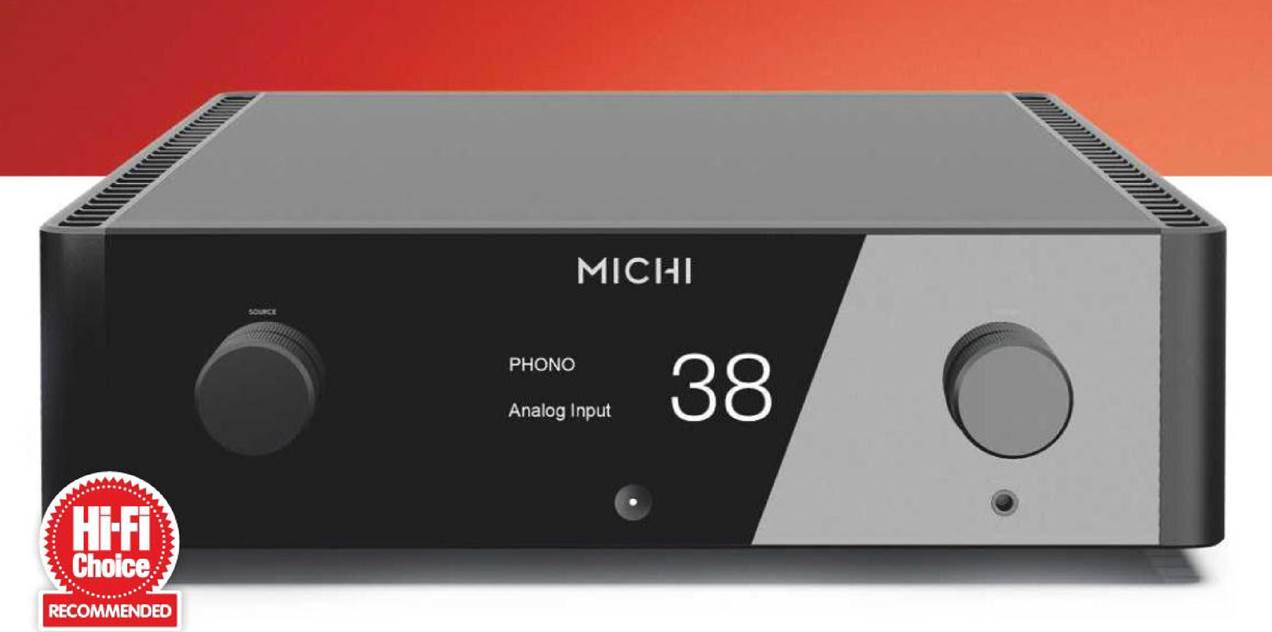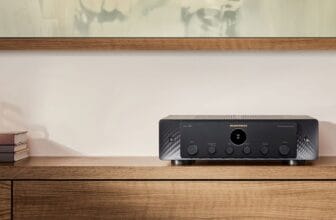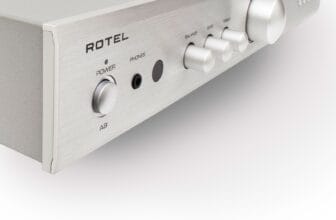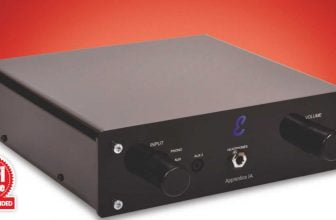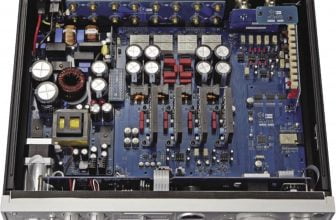Rotel Michi X3 Review – Rotel’s X appeal
The up-market Michi series makes a welcome return with two new integrated amplifiers overflowing with power, but can they match up to their EISA-award winning predecessors? Read our Rotel Michi X3 Review.
As years go, 1993 was a fairly inauspicious 12 months for the British music industry. With the nadir reached as Meat Loaf’s I’d Do Anything For Love (But I Won’t Do That) became the biggest-selling single, Take That scored their first number one with Pray and Mr Blobby breezed to the Christmas number one spot, it was perhaps a year to forget. However, over in the world of hi-fi a quiet revolution was occurring and Rotel was right at the heart of it.
Up until this point the family-run Japanese company was known for producing a series of solid performing components with a reputation for wallet-friendly pricetags. However, in 1993 it decided to take a leap into the unknown and introduce a series of money-no-object components giving its engineers free reign and telling them to set aside the idea of hitting an affordable pricepoint in favour of producing the very best product that money could buy. The resulting Michi range grew to include an active preamp, tuner and CD player, but more importantly cast Rotel in a new light. Suddenly the hi-fi equivalent of Aldi or Lidl was mixing it in the rarified company of Waitrose and Fortnum and Mason.
But then just as suddenly as Michi arrived and shook up the hi-fi market, it was gone… That is until last year when without any fanfare the marque
Massive power, ruthless control, unfettered dynamics and crisp cleanliness
returned with the P5 preamp, S5 stereo power amplifier and M8 monoblock. Of the trio, the P5 and S5 were reviewed in HFC 467, romping to a Recommended badge before going on to win an EISA award for their balance of power and substance. The good news is that unlike its ill-fated Nineties debut, it would appear that Michi is here to stay this time around as the next phase of the lineup has been unveiled
DETAILS
PRODUCT Rotel Michi X3
ORIGIN Japan TYPE Integrated amplifier WEIGHT 28.9kg
DIMENSIONS (WxHxD) 485 x 150 x 452mm
FEATURES
• Quoted power output: 2x 350W (4ohm)
• Inputs: 4x RCA; balanced XLR; MM phono stage; 3x optical; 3x coaxial; USB-B
• AptX/AAC Bluetooth
• 32-bit/768kHz DAC
DISTRIBUTOR Rotel Europe TELEPHONE 01903 221710
WEBSITE rotel.com
in the shape of the X5 and the X3 integrateds. And it’s towards the latter of these two that our attention now turns.
Like its predecessors, the X3 is substantial, beautifully designed and pretty damn powerful (rated as it is at 350W into 4ohm loads). Of course, bucketloads of power isn’t everything, so the fully populated rear panel suggests that it will also operate as a complex multi-source system if called upon to do so. It incorporates four sets of line inputs – one of which is balanced XLRs – a decent movingmagnet phono stage and a fairly comprehensive selection of digital inputs that feed its built-in 32-bit/768kHz AKM DAC. These include a trio of 24-bit/192kHz- friendly optical and coaxial inputs and a USB-B port to feed audio from a computer in the shape of PCM files up to 24-bit/384kHz or DSD128. An Ethernet input is on hand for networking, while a USB-A is available for firmware updates and the usual RS232, 12V triggering and external remote eye (so the amp can be hidden away in a cupboard yet still controlled) are present and correct. Wireless operation completes the picture in the form of aptX Bluetooth.
Lesser used but nonetheless useful options include a pair of mono sub outs, a brace of pre-outs – one of which can be used to add a second amplifier in order to bi-amp suitably equipped speakers – and a 6.35mm headphone jack on the front panel.
The mixture of matt and gloss black panels may be different to the original Michi ethos where lacquered wood and brushed aluminium were combined, but there’s something about its understated sleekness that’s highly appealing. And while at 485mm the X3’s chassis is perhaps wider than the hi-fi norm, its space-efficient design ensures it’s not another one of those ‘big intergrateds’ that look as hefty as they sound.
Sound quality
With all that power at its disposal, you’d be forgiven for thinking that the X3 is best suited for driving ‘problem’ speakers and to an extent, you’d be correct. However, while its massive power output – both continuous and dynamic – does make it ideal for speakers with lower sensitivity or challenging impedance, its even more impressive ruthless control, unfettered dynamics and crisp cleanliness – even when pushing extra hard -make it a perfect match for just about any loudspeaker you care to partner it with.
All of which results in a sound where clout and sparkle come together in a perfect ying and yang of balance to highlight open and detailed soundstaging where the recording permits alongside impeccable sharp focus and clarity. And while the X3 saves its very best for high-quality recordings – regardless of whether we’re talking vinyl, CD or via computer – it’s not afraid to get down and dirty with less pristine material too.
Take for example Pete & Diesel’s Live At Barrowlands set from 2020. Taking a Bandcamp download and playing it via Roon from a Mac mini, the X3 is able to deftly recapture all the excitement of this sellout gig as the rapturous audience sings along with every word. Triumphant and thrilling are the key takeaways here as the massive sound reproduced by the Michi captures the thrill of the whole experience, from the powerful drums to the rasping vocals.
As it to prove it can do the silk glove stuff just as well as the iron fist, the more gentle sound of Heron Valley’s Erie Storm really plays to the X3’s deft touch and agility. The definition of both vocals and the different
In sight
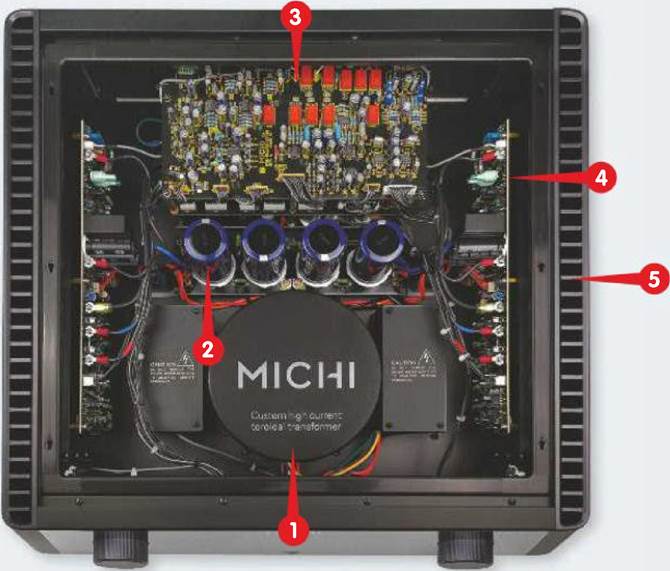
1) Large screened transformer feeds…
2) Strictly regulated power supplies
3) Three stacked PCBs host the line and phono stages, the main preamplifier and, underneath, the AK4490EQ-based DAC stage
4) Bipolar transistor power amp (one channel)
Integrated side panel and heatsink
THE NAME GAME
Taking its name from the Japanese word for direction, the Michi range emerged in the early Nineties and marked a clear intention for Rotel to steer the brand more in the direction of the high-end. But 1993 wasn’t the first time it had attempted this feat. Back in the late-Seventies, its RC-5000 preamp and RB-5000 stereo power amplifier came close. Boasting the CONTROL monicker on their front panels, the pair reflected the highly technical style of the time with the preamp home to a bewildering array of different knobs, flip switches, dials and sliders – including a 10-fader octave equaliser – while the power amplifier boasted both VU meters and peak level LEDS.
The Michi range that followed opted for a subtler approach to styling, with more of an industrial feel. The multitude of controls were promptly ditched without a VU meter in sight. Meanwhile new lacquered side panels were introduced in an effort to emphasis the use of more traditional Japanese craftmanship and each of the products boasted not just a number, but a Japanese name. Hence the RHC-10 passive controller was also known as Takumi (craftmanship), the RHQ-10 phono preamp was labelled Shih (poetry) and the RHB-10 dual mono power amplifier Kokoro (heart). Over time the range continued to grow to incorporate an active preamplifier, the RHA-10, the RHT-10 FM tuner, the RHCD-10 CD player and a second power amplifier in the shape of the RB-05. Then, just as suddenly as it had appeared, Michi was gone… That is until the emergence of the P5, S5 and M8 back in 2020.
IN SIGHT
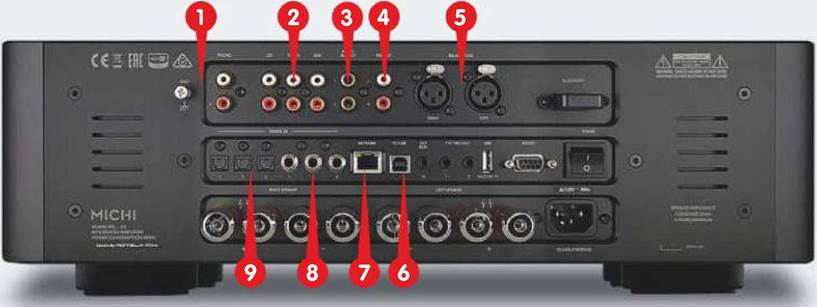
1) MM phono stage and grounding post
2) 3x stereo RCA inputs
3) 2x mono subwoofer outputs
4) Pre outputs
5) Balanced XLR ins
6) USB-B port for PC
7) Ethernet port
8) 3x coaxial inputs
9) x optical inputs
instruments are every bit as notable as the way the rhythms drive along with a slick combination of delicacy of touch and outright slam. Take You There, for example, builds from its gentle middle section interlude towards its fiery end like a horse racing commentator slowly ramping himself up as a backrunner threads its way through the field before romping to a photo finish in the Derby. Meanwhile, the sheer brio of second
The massive sound perfectly captures the thrill of the live music experience
track Anna’s and delicacy of its pipes should be enough to bring a smile to even the most downcast listener.
The same lightness of touch comes to the fore as Belgian soprano Jodie Devos tries his hand at ‘doing a Freddie’ with the former Queen frontman’s You Take My Breath Away. With Devos’ unmistakable vocal accompanied by simple piano, the breath-taking acoustic sees the notes hang in the air in a wonderfully affecting way as if the whole Covid thing had all been a bad dream and


hearing music in intimate venues was something we could all do routinely.
But as impressive as all this lightness of touch stuff is, when there’s as much power under the hood as the Michi has, it’d be remiss of us not to turn the wick up to see how it purrs. Enter Dire Straits and Sultans Of Swing. Familiar though this undeniably is, suddenly the flat-out drive of the bass and percussion with the ultra-fine detail of Mark Knopfler’s intricate guitar work sound totally reinvigorated, like hearing the track for the first time. The same can be said for the deft fingerwork on the piano of Bob James’ Lost. Whether playing straight down the line on Serenata with Bill Wood on bass and drummer Omar Clay or the more relaxed jamming of the opening track, the Michi has all the speed, warmth and control to maximise both the performance and pristine quality of the recording.
A final reminder of power, as if it were needed, comes courtesy of Shostakovich’s Ninth Symphony played by the LSO under the baton of Gianandrea Noseda. If it’s drama you want, why not try cranking the volume up and being blown away by the huge dynamic swings, while throughout there’s no hardening of the sound as the Michi X3 effortlessly goes through the motions, barely breaking into a sweat.
Conclusion
With so much power at its disposal, it won’t come as a surprise to learn that the Michi X3 can play piledriver when it’s called upon. But power is nothing without control and finesse and it’s here that it earns its stripes. While speed, agility and warmth are among this integrated’s attributes, what really impresses here is its gossamer- fine lightness of touch. Suddenly all that power is thrown into sharp relief, becoming more rewarding in the process. Throw in a deft mix of top-notch build quality, flexibility and supreme styling, and you’d be forgiven for thinking that Michi might just be here to stay this time around •
OUR VERDICT
HOW IT COMPARES
When it comes to the Michi X3’s phenomenal W-per- £ performance, Rotel rather hides its light under a bushel. We’ve not tested any amps that best its power at under. If you’ve more funds Hegel’s H590 (HFC 449) offers a similarly prodigious output with a networked DAC onboard – it sounds blissfully smooth and confident too. Equally large of case is Musical Fidelity’s latest behemoth, the M8xi (HFC 465), which more than meets its 550W spec even if the X3 still has an edge driving the lowest impedance loudspeakers.
